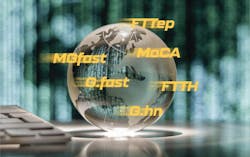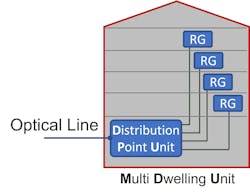Phase Two of Fiber Transformation Starts Now
The imperative to reach and empower broadband for gigabit services is well underway but its impact is just beginning. Most easily reached areas were covered by Phase One of fiber rollout. Up to now, the rollout picked the low hanging fiber fruit to access a small and often privileged minority of homes in conveniently placed locations. What remains now are areas where building fiber-only access is difficult to financially justify.
What has been missing is the ability to extend gigabit capabilities to a new stratum of customers that cannot be affordably reached with this fiber-only strategy. This has been an historical problem with providers struggling to recover the cost of fiber installations. In the past, they have lacked decent alternatives that are too costly and have lengthy install timelines.
"The notion that only fiber can support modern, gigabit service is not valid. Options for transmission over the short copper wires to the home include: MGfast, G.fast, G.hn, and MoCA."
Phase Two is based on a generation of hybrid-fiber solutions that can reach millions more end-users—making high-speed broadband affordable for users while avoiding daunting provider installation costs and lengthy delays of new construction. Phase Two combines fiber and new copper technologies to deliver gigabit class services.
This second phase of fiber transformation can enable new economic growth by connecting those who are not currently served in the distributed workforce, multi-tenant businesses, multi-dwelling buildings, and homes. It can also pave the way to upgrade existing broadband connectivity in line with new higher speed FCC broadband requirements. Finally, it can help fulfill the U.S. government’s funding intentions to reach underserved communities.
This article reviews the latest technologies that can deliver hybrid gigabit services with significant cost savings to a much-extended range of customers. It concludes by summarizing the connectivity and commercial impact of Phase Two.
If This Is Phase Two, What Was Phase One?
The U.S. Census Bureau1 estimates there will be growth to 132 million households by 2022 as shown in Figure 1. According to the well-covered study2 published in 2022 by the Fiber Broadband Association, fiber has reached about 43% of these (60.5 million) with only 24.3 million actually directly connected to the Internet via fiber. The question is why and what can be done?
Providers have done a great job of deploying fiber to the neighborhood, a.k.a. “homes passed” but not into actual “homes served”. Realistically, the policy of taking fiber-to-the-home is too expensive.
Phase One led with the assumption that fiber-only was the approach providers should take. Phase Two dispels that fallacy. What’s new in Phase Two are the latest copper gigabit standards and secured communication technologies highlighted in Figure 4 below.
Technology Options for Fiber Transformation Phase Two
The notion that only fiber can support modern, gigabit service is not valid. Options for transmission over the short copper wires to the home include: MGfast, G.fast, G.hn, and MoCA.
FTTep
In many places, building fiber cable is very expensive, especially in the last segment. In these situations, using existing coax or phone wiring to reach the last few hundred feet is a much more practical and cost-effective approach. Broadband Forum TR-419 describes Fiber-to-the-Extension-Point (FTTep) as a variety of technologies that can carry gigabit service over existing wires to each home at a cost far less than Fiber-to-the-Home (FTTH). (See Figure 2.)
In these cases, the network Distribution Point Unit (DPU) multiplexer is usually located near customer homes. It uses fiber backhaul to the exchange, and copper-transmission technologies such as G.fast to carry gigabit service the last few hundred feet to homes. However, if fiber backhaul from the DPU to the exchange is not feasible, the DPU backhaul can be achieved using G.fast technology over existing telephone wires.
ITU-T standard G.9702 (G.fastback) was approved in 2022, specifying DPU backhaul by bonding multiple G.fast lines, typically up to 16 lines and allowing backhaul speeds to 10 gigabits and beyond. Thus, the existing telephone wires can be utilized on both the network-side and customer-side of the DPU. Furthermore, the backhaul reach can be extended to nearly a mile by installing line-powered, mid-span amplifiers. This extends the FTTep concept of using fiber where it makes sense and use the existing copper wires to reach where fiber cannot, including power over copper when none is available. (See Figure 3.)
MGfast
ITU-T standard G.9701 for G.fast specifies transmission up to 2 Gb/s over telephone wires, coax, and Ethernet cables up to 1,500 feet. Dynamic Time Assignment enables G.fast lines to automatically reallocate the transmission capacity between the downstream and upstream directions in response to the customer’s traffic to support gigabit data rates in either direction.
ITU-T Standards G.9710, G.9711 and G.997.3 specify MGfast, the newest copper wire transmission technology. Using full-duplex transmission up to 424 MHz, MGfast can achieve an aggregate bit rate up to 10 Gb/s on coax and CAT 5e/6 wire. On traditional telephone wires, MGfast can exceed the maximum bit rate of what is already achieved by today’s G.fast technology (2 Gb/s). Like G.fast, MGfast can operate on wires up to 1,500 feet.
G.hn
ITU-T standards G.9960 and G.9961 for G.hn specify transmission up to 10 Gbps over coax (using a bandwidth of 2 GHz), and up to 3 Gbps on telephone and Ethernet cables (using a bandwidth up to 400 MHz). G.hn can operate over wires up to 1,500 feet. What’s new is that G.hn may now be used for access from the DPU to the home, especially with the new “Vector Boost” technique that enables G.hn to operate in multipair telephone cables by avoiding crosstalk between the wires. As with MGfast and G.fast, G.hn can carry the gigabit service over wires within the premises as well as to the home.
MoCA
MoCA Access 2.5 provides 2.5 Gbps downstream, 2.0 Gbps upstream over coax wires, supporting point-to-point and point-to-multipoint over a distance up to 500 feet.
FTTH
The new ITU-T G.9804 50G-PON will soon provide up to 50x50 Gbps FTTH. The fiber PON capacity may be shared by up to 32 customers, to provide service speeds from 300 Mbps to 5 Gbps. FTTH has been the default way to connect homes and offices to the Internet at gigabit speed.
ITU-T standard G.984x specifying 2.5x1.25 Gbps GPON has been widely deployed, and now G.9807.1 XGS-PON is an increasingly popular way to provide 10x10 Gbps FTTH.
Phase Two: Affordable Connections for Millions More Households
- From the market segmentation shown in Figure 1, hybrid gigabit services have the potential to connect 35 million new gigabit households yielding provider revenues in the order of $25 billion per year. Figure 2 shows that Phase Two can greatly help speed installation with accompanying reduced costs.
- These offerings also incent providers to upgrade existing broadband services to gigabit performance using new hybrid fiber for their current customers. Figure 2 also shows that using these copper technologies could enable an additional 25-40 million households in network upgrades.
- These solutions could help providers deliver on the commitments they must make to receive portions of the $65 billion from various U.S. federal grants. These monies are intended to reach the majority of the 17 million underserved subscribers in target communities and there will be significant oversight across the life cycle of this program. Phase Two will enable far more households to be connected for the same funding in these areas.
“Phase Two is based on a generation of hybrid-fiber solutions that can reach millions more homes making high-speed broadband affordable for users without the daunting provider installation costs and lengthy delays of new construction. Phase Two combines fiber and new copper technologies to deliver gigabit class services.”
These three areas of growth will take time, of course. In addition, not every remote area providers’ aim to serve may be reachable via terrestrial means. However, Phase Two is a big step toward enabling lower cost connectivity, economic business, and provider opportunities.
Thankfully, products and services are available today to capitalize on this opportunity. Several vendors provide equipment supporting Phase Two hybrid fiber access. One example is the Actelis hybrid fiber equipment that was featured in the winners of the recent IEEE ComSoc award3 for products to help end the digital divide. For full details on the Actelis range of hybrid fiber products, visit www.actelis.com.
This year has been a transformative year in thinking about how billions of dollars in government funding can be well spent. Perhaps over the next few years, this thinking will translate into fruitful actions that help the “digital divide” become a distant memory. One that exists only in the history books.
REFERENCES AND NOTES
1. U.S. Census Bureau: https://www.census.gov/quickfacts/fact/table/US/HCN010217
2. Fiber Broadband Association: https://www.fiberbroadband.org/blog/fiber-broadband-enters-largest-investment-cycle-ever
3. IEEE ComSoc Award: https://actelis.com/actelis-to-win-1st-place-for-na-in-ieee-comsoc-internet-for-all-competition/
About the Author
Tom Starr
Member of the Actelis Advisory Board
Tom Starr is an author and expert on broadband access, serving as President and Chairman of the Broadband Forum for many years, Chairman of the ITU-T international standards committee (WP1/15) that produces the global standards for broadband access technology, and the author of the 2022 first place winning paper for the IEEE Communications Society “Internet for All” completion. Tom was a Lead Member of Technical Staff at AT&T for 44 years and the author of three books on broadband technology. For more information, email [email protected] or visit www.actelis.com . Follow him on LinkedIn: https://www.linkedin.com/in/tom-starr-84837013/.
Mark Fishburn
Provider of Strategic Network, Cybersecurity and Marketing Services
Mark Fishburn | Provider of Strategic Network, Cybersecurity and Marketing Services.
Mark is CEO of cybyr.com and has five decades of experience in software, networking, and security. He is a member of ONUG, MEF and CSA network and security working Groups, CISA contributor and publisher of the Holistic Cybersecurity book: Hey Who Left The Back Door Open? For more information, or to give feedback, email [email protected] or follow him on LinkedIn.






